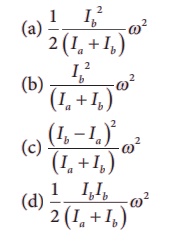Physics - Motion of System of Particles and Rigid Bodies: Multiple choice questions with answers | 11th Physics : UNIT 5 : Motion of System of Particles and Rigid Bodies
Chapter: 11th Physics : UNIT 5 : Motion of System of Particles and Rigid Bodies
Motion of System of Particles and Rigid Bodies: Multiple choice questions with answers
1.
The center of mass of a system of particles does not depend upon,
(a)
position of particles
(b)
relative distance between particles
(c)
masses of particles
(d) force acting on particle
2.
A couple produces,
(a) pure rotation
(b)
pure translation
(c)
rotation and translation
(d)
no motion
3.
A particle is moving with a constant velocity along a line parallel to positive
X-axis. The magnitude of its angular momentum with respect to the origin is,
(a)
zero
(b)
increasing with x
(c)
decreasing with x
(d) remaining constant
4.
A rope is wound around a hollow cylinder of mass 3 kg and radius 40 cm. What is
the angular acceleration of the cylinder if the rope is pulled with a force 30
N?
(a)
0.25 rad s–2
(b) 25 rad s–2
(c)
5 m s–2
(d)
25 m s–2.
5.
A closed cylindrical container is partially fi lled with water. As the container
rotates in a horizontal plane about a perpendicular bisector, its moment of
inertia,
(a) increases
(b)
decreases
(c)
remains constant
(d)
depends on direction of rotation.
6.
A rigid body rotates with an angular momentum L. If its kinetic energy is
halved, the angular momentum becomes,
(a)
L
(b)
L/2
(c)
2L
(d) L/ 2
7.
A particle undergoes uniform circular motion. The angular momentum of the particle
remain conserved about,
(a) the center point of the circle.
(b)
the point on the circumference of the circle.
(c)
any point inside the circle.
(d)
any point outside the circle.
8.
When a mass is rotating in a plane about a fi xed point, its angular momentum
is directed along,
(a) a line perpendicular to the
plane of rotation
(b)
the line making an angle of 45° to the plane of rotation
(c)
the radius
(d)
tangent to the path
9.
Two discs of same moment of inertia rotating about their regular axis passing through
center and perpendicular to the plane of disc with angular velocities ω1
and ω2. They are brought in to contact face to face coinciding the
axis of rotation. The expression for loss of energy during this process is,
(a) 1/4 I (ω1- ω2)2
(b)
I (ω1- ω2)2
(c)
1/8 I (ω1- ω2)2
(d)
1/2 I (ω1- ω2)2
10.
A disc of moment of inertia Ia is rotating in a horizontal plane
about its symmetry axis with a constant angular speed ω. Another discinitially
at rest of moment of inertia Ib is dropped coaxially on to the
rotating disc. Then, both the discs rotate with same constant angular speed.
The loss of kinetic energy due to friction in this process is,

Ans:d
11.
The ratio of the acceleration for a solid sphere (mass m and radius R) rolling
down an incline of angle θ without slipping and slipping down the incline
without rolling is,
(a) 5:7
(b)2:3
(c)
2:5
(d)
7:5
12.
From a disc of radius R a mass M, a circular hole of diameter R, whose rim
passes through the center is cut. What is the moment of inertia of the remaining
part of the disc about a perpendicular axis passing through it
(a)
15MR2/32
(b) 13MR2/32
(c)
11MR2/32
(d)
9MR2/32
13.
The speed of a solid sphere after rolling down from rest without sliding on an
inclined plane of vertical height h is,

Ans: a
14.
The speed of the center of a wheel rolling on a horizontal surface is vo.
A point on the rim in level with the center will be moving at a speed of speed
of,
(a)
zero
(b)
vo
(c) √2vo
(d)
2vo
15.
A round object of mass M and radius R rolls down without slipping along an
inclined plane. The fractional force,
(a)
dissipates kinetic energy as heat.
(b)
decreases the rotational motion.
(c)
decreases the rotational and transnational motion
(d) converts transnational energy
into rotational energy
Answers:
1)
d 2) a 3) d 4) b
5)
a 6) d 7) a 8) a
9)
a 10) d 11) a 12) b
13)
a 14) c 15) d
Related Topics